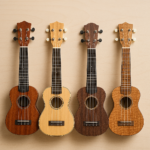
The mandolin is a captivating string instrument known for its bright, resonant sound and unique construction. With a rich history and a diverse range of musical applications, it has become a favorite among musicians across various genres, from bluegrass to classical. This article explores intriguing facts about the mandolin, including its notable brands, learning curve, acoustic properties, and cultural variations, highlighting its enduring appeal and significance in the world of music.
Origin: The mandolin originated in Italy during the 17th century, evolving from earlier stringed instruments like the lute. Its design and construction were influenced by the cultural and musical trends of the time, particularly the rise of instrumental music in Italy. The early mandolins were often strummed with a plectrum and featured a rounded back, which contributed to their distinctive sound. Over the centuries, the mandolin spread throughout Europe and eventually made its way to America, where it became a staple in various musical genres.
Strings: A standard mandolin is equipped with eight strings, which are organized into four pairs known as courses. Each pair is tuned in unison, meaning both strings in a pair are set to the same pitch. This unique arrangement allows for a bright, ringing tone that is characteristic of the instrument. The eight-string setup also enables a wide range of harmonies and melodies, making the mandolin a versatile choice for musicians. The courses are typically made of metal, which enhances the instrument’s projection and sustain.
Tuning: The most common tuning for the mandolin is G-D-A-E, starting from the lowest course to the highest. This tuning is similar to that of a violin, which allows mandolin players to apply techniques and fingerings from violin playing. The G course is the lowest pitch, followed by the D, A, and E courses, which are the highest. This tuning not only facilitates the playing of melodies but also supports chordal accompaniment, making it suitable for both solo performances and ensemble settings. Players often use a tuner or tuning app to ensure their instrument is accurately tuned before playing.
Body Shape: Mandolins are available in various body shapes, with the A-style (teardrop) and F-style (with scroll and points) being the most popular. The A-style mandolin has a simpler, more rounded appearance, while the F-style features ornate design elements, including a scroll at the headstock. The body shape influences the instrument’s tonal qualities; for example, F-style mandolins are often favored for their projection and clarity. Both styles are crafted to enhance the instrument’s resonance, contributing to the unique sound that mandolins are known for.
Construction: The construction of a mandolin typically involves high-quality solid woods, with spruce commonly used for the top and maple for the back and sides. The choice of materials significantly impacts the instrument’s sound quality and durability. Spruce is known for its excellent tonal properties, providing a bright and clear sound, while maple contributes to a warm, rich tone. The craftsmanship involved in building a mandolin is crucial, as it affects not only the aesthetics but also the acoustic performance of the instrument. Many luthiers take great care in selecting woods that will resonate well together.
Playing Technique: Mandolin players often use a plectrum, or pick, to strum or pluck the strings, which produces a bright, sharp sound. The technique can vary from player to player, with some favoring a rapid picking style while others may employ fingerpicking methods. The use of a plectrum allows for greater control over dynamics and articulation, enabling musicians to achieve a wide range of expressive sounds. Additionally, players often incorporate techniques such as tremolo, slides, and hammer-ons to enhance their playing and add complexity to their music.
Genres: The mandolin is a versatile instrument that finds its place in various music genres, including bluegrass, classical, folk, and country. In bluegrass music, the mandolin often serves as a lead instrument, providing melodic lines that complement the banjo and guitar. In classical music, the mandolin is featured in orchestral settings and chamber music, showcasing its ability to blend with other string instruments. Folk music traditions around the world also embrace the mandolin, using it to accompany songs and dances. This adaptability has helped the mandolin maintain its popularity across diverse musical landscapes.
Famous Players: Notable mandolin players have made significant contributions to the instrument’s popularity and evolution. Bill Monroe, often referred to as the “Father of Bluegrass,” played a pivotal role in popularizing the mandolin in American music. His innovative playing style and compositions showcased the mandolin’s capabilities within bluegrass ensembles. Chris Thile, a contemporary mandolin virtuoso, has further expanded the instrument’s reach by blending genres such as classical, jazz, and progressive acoustic music. David Grisman is another influential figure known for his unique blend of bluegrass, jazz, and folk influences, helping to establish the mandolin as a prominent instrument in modern acoustic music.
Tremolo: Tremolo is a distinctive technique used on the mandolin, characterized by rapidly alternating pick strokes that create a sustained sound. This technique is particularly effective on the mandolin due to its unique string arrangement and construction. When executed properly, tremolo can produce a lush, shimmering effect that enhances melodies and adds emotional depth to performances. Players typically achieve tremolo by using a wrist motion to alternate the pick strokes quickly, allowing for a continuous sound without interruption. This technique is often employed in both solo performances and ensemble settings, where it can provide a rich layer of texture. Tremolo is especially prominent in classical mandolin compositions and traditional folk music, showcasing the instrument’s expressive capabilities.
Mandolin Family: The mandolin is part of a larger family of instruments that includes the mandola, mandocello, and octave mandolin. Each of these instruments has a unique range and tuning, contributing to the overall versatility of the mandolin family. The mandola is typically tuned a fifth lower than the mandolin and has a deeper, richer sound, making it suitable for harmony and accompaniment roles. The mandocello, tuned an octave lower than the mandolin, provides a bass voice within the family, often used to support melodies and add depth to arrangements. The octave mandolin, tuned an octave lower than the standard mandolin, offers a similar timbre but with a fuller sound. Together, these instruments can create a rich tapestry of sound in both solo and ensemble performances, allowing for intricate harmonies and melodies.
Historical Use: The mandolin gained popularity during the 18th and 19th centuries, particularly in Europe, where it was often featured in salons and home music-making. It became a favorite among amateur musicians and was commonly used in social gatherings, where people would perform for entertainment. The instrument’s portability and relatively simple playing technique made it accessible for many, leading to its widespread appeal. During this period, composers began writing specific pieces for the mandolin, further solidifying its role in both popular and classical music. Its presence in operas and theatrical performances also helped elevate its status as a respected instrument.
Cultural Significance: In Italian culture, the mandolin is closely associated with traditional folk music, particularly in the southern regions of Italy, such as Naples. It is often featured in Neapolitan songs, which are characterized by their romantic themes and lively melodies. The mandolin’s bright sound complements the expressive singing typical of this genre. Additionally, the instrument plays a significant role in Italian festivals and celebrations, where musicians often perform in ensembles. Its cultural significance has led to the establishment of mandolin festivals and competitions, celebrating both traditional and contemporary playing styles.
Fretboard: The mandolin features a fretted neck, similar to that of the guitar, allowing for precise note playing. The fretboard is typically made of hardwood, providing durability and a smooth playing surface. The arrangement of frets allows players to easily navigate the instrument’s range and play melodies, chords, and scales. The standard mandolin fretboard has 29 frets, enabling access to a wide range of pitches. Players often utilize different fingerings and techniques to create intricate melodies and harmonies, making the fretboard a crucial aspect of mandolin playing.
Scale Length: The scale length of a standard mandolin is approximately 13.875 inches (35.24 cm). This measurement refers to the distance from the nut (the piece at the end of the neck) to the saddle (the bridge on the body). The scale length affects the instrument’s playability and tonal qualities; a shorter scale length typically results in a warmer sound and easier finger reach for players. The standard scale length of the mandolin allows for comfortable playing while still providing the bright, ringing tone that the instrument is known for. This length also facilitates the use of various playing techniques, such as bending notes and executing fast passages.
Weight: A typical mandolin weighs between 1.5 to 2.5 pounds (0.68 to 1.13 kg), making it relatively lightweight and easy to handle. This portability is one of the reasons for its popularity among musicians who perform in various settings, from casual gatherings to professional concerts. The lightweight nature of the mandolin allows for extended playing sessions without causing significant fatigue, making it an ideal choice for both beginners and seasoned players. The construction materials and design also contribute to the overall weight, with solid woods providing a balance between durability and sound quality.
Resonance: The mandolin’s body shape and construction significantly contribute to its resonant sound. The combination of solid woods, such as spruce and maple, helps create a rich tonal quality that is both bright and warm. The arched top and back of the mandolin enhance its projection, allowing the sound to carry well in various performance environments. This resonance is essential for both solo performances and ensemble playing, where the mandolin needs to cut through the mix of other instruments. The design principles used in crafting mandolins have been refined over centuries, resulting in instruments that are not only visually appealing but also acoustically impressive.
Plectrum Types: Mandolin players often experiment with different types of plectrums (picks) to achieve their desired sound and playing style. Plectrums come in various materials, thicknesses, and shapes, each affecting the tone and playability of the instrument. Heavy picks tend to produce a louder, more aggressive sound, while lighter picks allow for greater finesse and subtlety in playing. Some players prefer a rounded tip for smooth strumming, while others may choose a sharper tip for precise picking. The choice of plectrum is a personal preference that can greatly influence a player’s technique and overall sound.
Notable Brands: The mandolin market features several reputable manufacturers known for their craftsmanship and sound quality. Gibson, a historic American brand, has been producing mandolins since the early 1900s, with models like the F-5 being particularly revered among musicians. Collings, a relatively newer brand, is celebrated for its attention to detail and high-quality materials, appealing to both professional and amateur players. Eastman, known for its affordability and quality, has gained popularity for providing handcrafted instruments that cater to a wide range of budgets, making it accessible for aspiring mandolinists.
Learning Curve: The mandolin is often praised for its approachable learning curve, especially for beginners. Its compact size makes it easy to handle, and its tuning is similar to that of a violin, which is in fifths (G-D-A-E). This tuning system allows for straightforward finger placements and chord shapes, making it easier for new players to pick up and start playing songs quickly. Additionally, the mandolin’s lightweight design and smaller body can be less intimidating for those who may find larger instruments, like the guitar, cumbersome.
Crossover Instruments: The mandolin’s versatility extends beyond its traditional roots, as it has found a place in various orchestral settings. In these environments, it blends harmoniously with string instruments like violins and cellos, as well as woodwinds. The mandolin’s bright, clear tones can add a unique texture to orchestral arrangements, enriching the overall soundscape. Its ability to adapt to different musical styles allows it to be featured in classical compositions, contemporary pieces, and even film scores, showcasing its dynamic range.
Music Notation: Mandolin music is typically presented in both standard notation and tablature, making it accessible to a broad audience. Standard notation provides a comprehensive understanding of musical theory and allows players to read music written for various instruments. Tablature, on the other hand, offers a simplified visual representation of the fretboard, indicating where to place fingers on the strings. This dual approach caters to musicians of all skill levels, enabling beginners to start playing quickly while still offering depth for more advanced players who wish to explore complex pieces.
International Variants: The mandolin has inspired various regional adaptations, reflecting the cultural diversity of string instruments worldwide. For instance, the Portuguese “bandolim” features a slightly different shape and tuning, often used in traditional Fado music. The Greek “bouzouki,” while distinct in design, shares similarities with the mandolin and plays a significant role in Greek folk music. These international variants highlight the mandolin’s influence across different cultures and its ability to adapt to various musical traditions, enriching the global music landscape.
Acoustic Properties: The construction of a mandolin significantly impacts its sound quality, with many high-end models utilizing solid woods such as spruce for the top and maple for the back and sides. Solid woods are preferred over laminated materials because they resonate better, producing a fuller and more vibrant sound. The craftsmanship involved in shaping the wood also affects the instrument’s tonal characteristics, allowing for a range of sounds from bright and punchy to warm and mellow. This attention to acoustic properties is crucial for musicians seeking to achieve a specific sound in their performances.
Influence on Bluegrass: The mandolin has been integral to the development of bluegrass music, a genre that emerged in the 1940s. It often serves as a lead instrument, providing melodic lines that complement the driving rhythms of the guitar and banjo. Renowned mandolinists like Bill Monroe, considered the “Father of Bluegrass,” have showcased the instrument’s capabilities through virtuosic playing and innovative techniques. The mandolin’s role in bluegrass not only highlights its musical versatility but also solidifies its place in American musical heritage.
Popularity: In recent years, the mandolin has experienced a resurgence in popularity, particularly within folk and Americana music circles. This revival can be attributed to the instrument’s unique sound and its ability to blend with a variety of musical styles. Increased visibility through social media, music festivals, and collaborations among artists has introduced the mandolin to new audiences, inspiring a new generation of musicians to explore its rich tonal palette. As a result, the mandolin continues to thrive, fostering a vibrant community of players and enthusiasts.
Frequently Asked Questions About the Mandolin
General Questions
1. What is a mandolin?
A mandolin is a small, stringed musical instrument with a pear-shaped body, a fretted neck, and eight strings. It is typically tuned to a reentrant tuning, meaning the strings are tuned in pairs, with the top four strings tuned an octave higher than the bottom four.
2. Where did the mandolin originate?
The exact origin of the mandolin is debated, but it is believed to have developed from instruments that were popular in the Middle East and Europe during the Middle Ages.
3. What is the difference between a mandolin and a ukulele?
While both the mandolin and ukulele are small, stringed instruments, they have several key differences. The mandolin has eight strings and is typically tuned to a reentrant tuning, while the ukulele has four strings and is typically tuned to a reentrant tuning. The mandolin also has a larger body and a longer neck than the ukulele.
Types of Mandolins
4. What are the different types of mandolins?
There are several different types of mandolins, including:
- F-style mandolin: This is the most common type of mandolin, characterized by its f-shaped body.
- A-style mandolin: This type of mandolin has a smaller, oval-shaped body.
- Bouzouki: A bouzouki is a larger version of the mandolin with four pairs of strings.
- Mandola: A mandola is a mandolin with a longer neck and lower tuning.
Playing the Mandolin
5. How do you play a mandolin?
The mandolin is played by plucking the strings with a pick or with your fingers. The fretted neck allows for playing a variety of notes and chords.
6. What kind of music is the mandolin used for?
The mandolin is used in a variety of musical genres, including bluegrass, folk, country, and jazz. It is often used for melodic lines and rhythm accompaniment.
7. Is the mandolin difficult to learn?
Learning to play the mandolin can be challenging, but it is possible for anyone with the desire and dedication to learn. There are many resources available online and in books to help beginners get started.
Famous Mandolin Players
8. Who are some famous mandolin players?
Some famous mandolin players include Bill Monroe, Earl Scruggs, Chris Thile, and David Grisman. These musicians have made significant contributions to the development of mandolin music.









